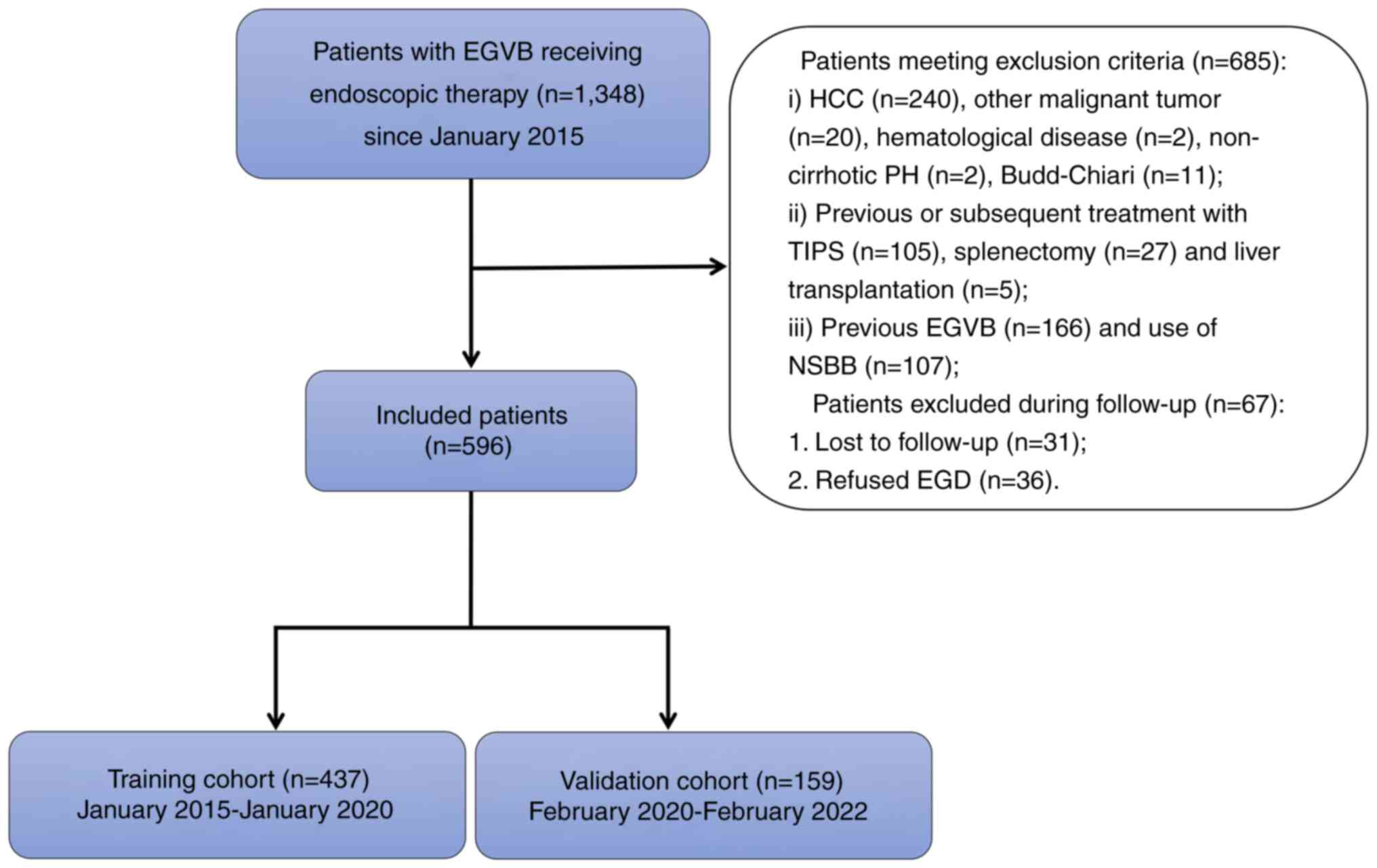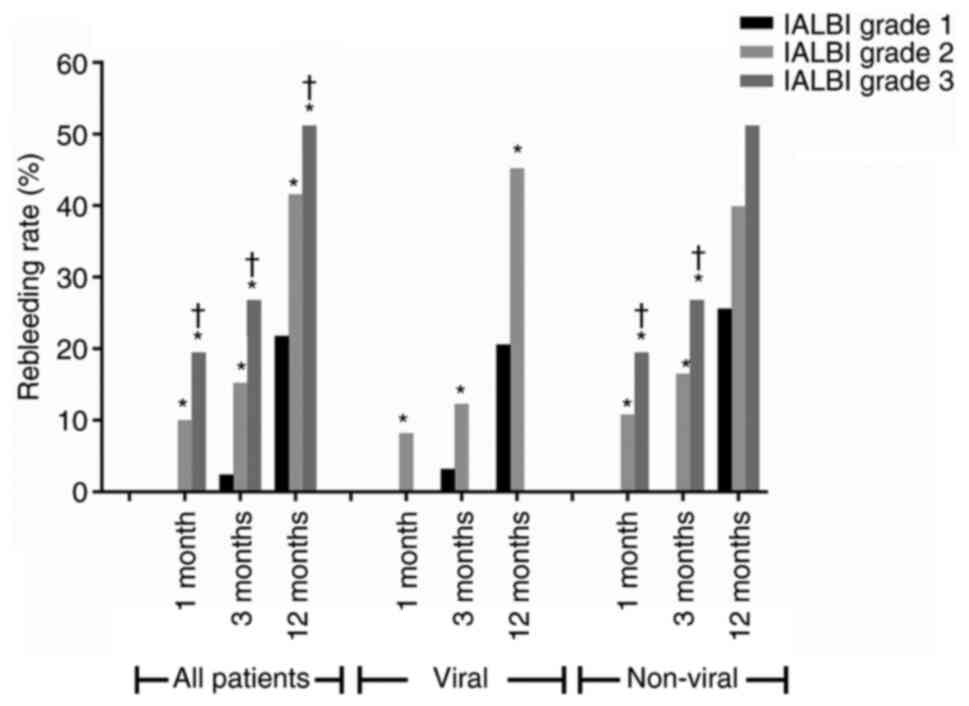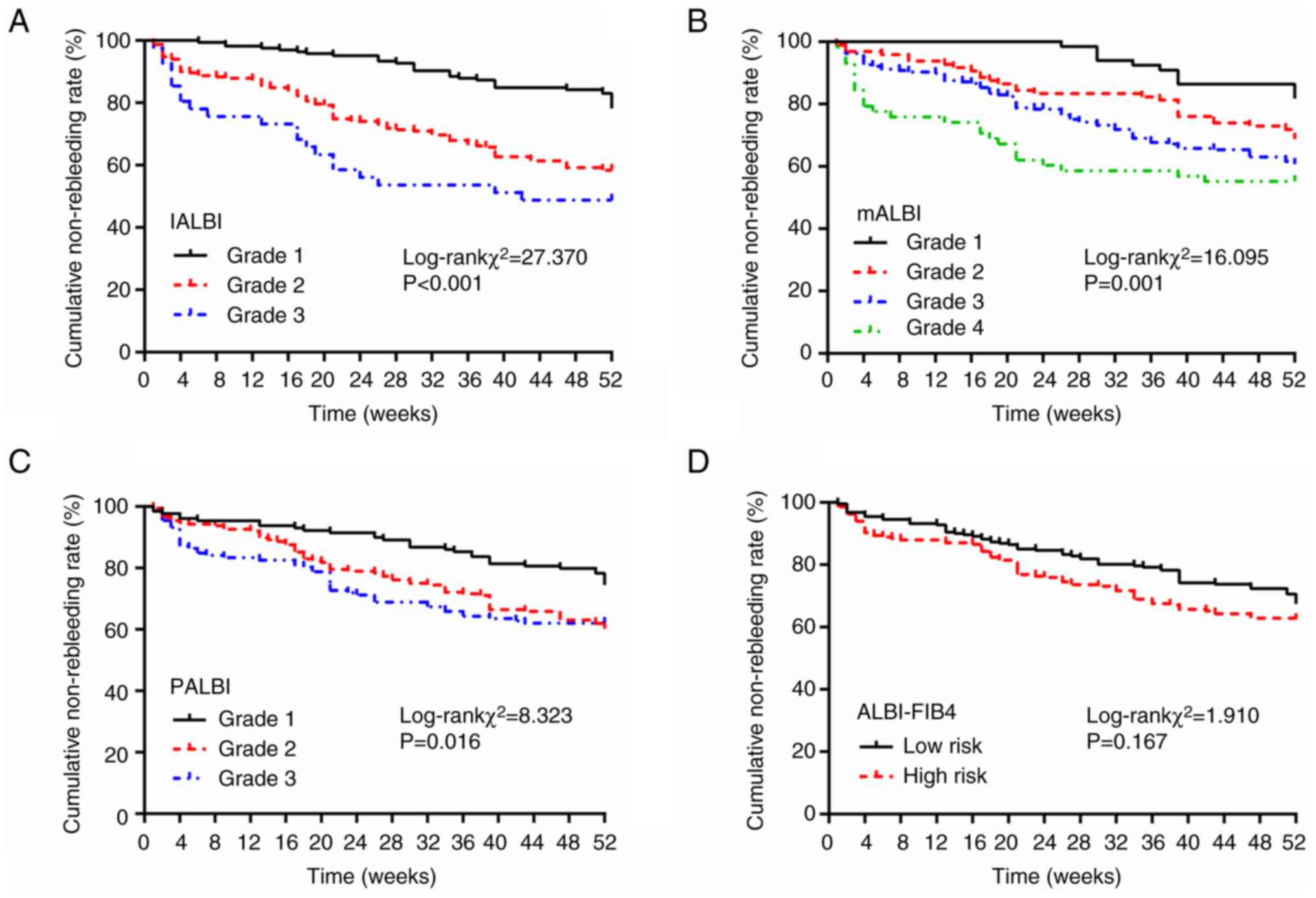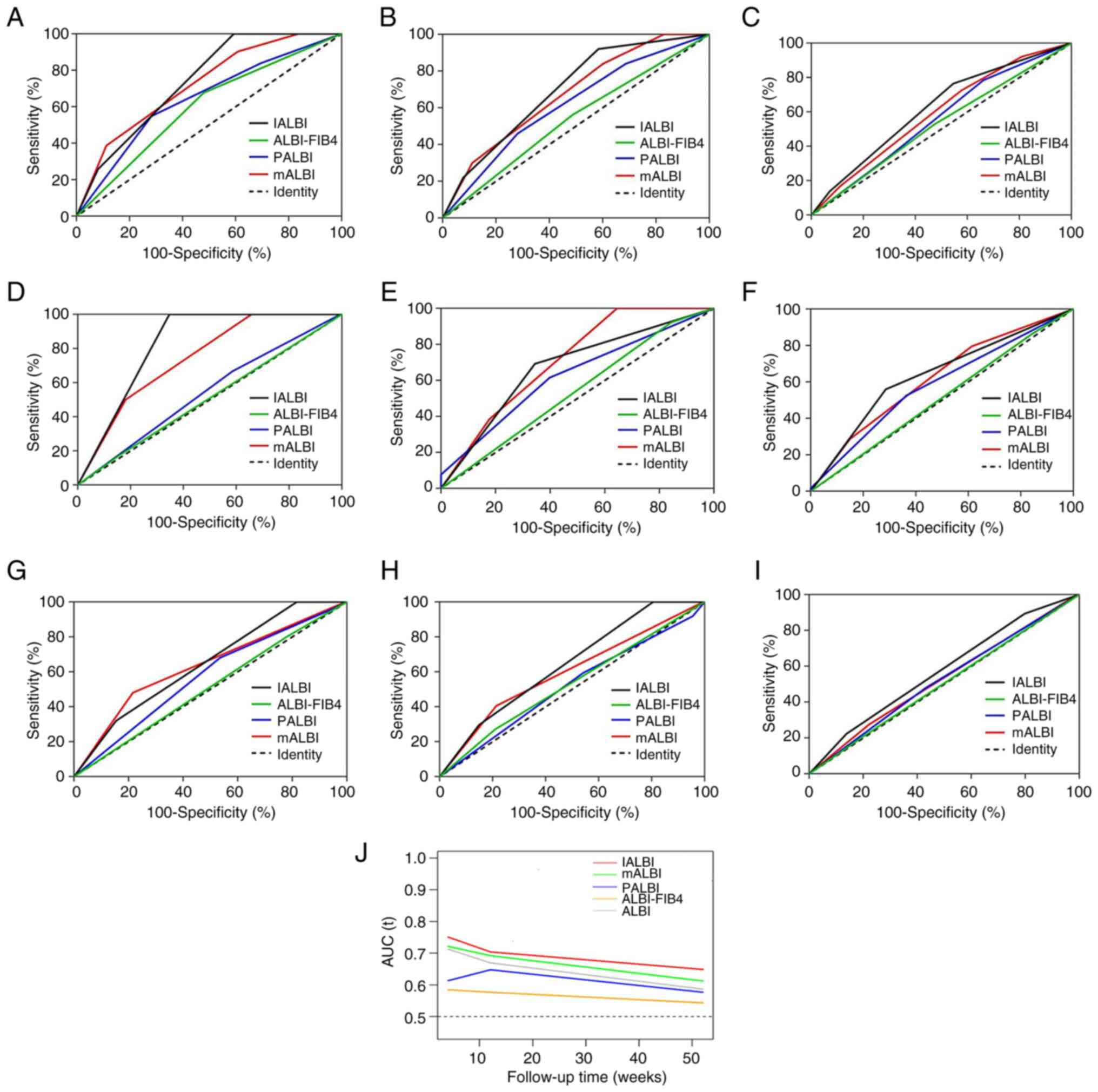|
1
|
Alqahtani SA and Jang S: Pathophysiology
and management of variceal bleeding. Drugs. 81:647–667.
2021.PubMed/NCBI View Article : Google Scholar
|
|
2
|
Drolz A, Ferlitsch A and Fuhrmann V:
Management of coagulopathy during bleeding and invasive procedures
in patients with liver failure. Visc Med. 34:254–258.
2018.PubMed/NCBI View Article : Google Scholar
|
|
3
|
Conn HO, Grace ND, Bosch J, Groszmann RJ,
Rodés J, Wright SC, Matloff DS, Garcia-Tsao G, Fisher RL and Navasa
M: Propranolol in the prevention of the first hemorrhage from
esophagogastric varices: A multicenter, randomized clinical trial.
The Boston-New Haven-Barcelona portal hypertension study group.
Hepatology. 13:902–912. 1991.PubMed/NCBI
|
|
4
|
Kezer CA and Gupta N: The role of
therapeutic endoscopy in patients with cirrhosis-related causes of
gastrointestinal bleeding. Curr Gastroenterol Rep.
20(31)2018.PubMed/NCBI View Article : Google Scholar
|
|
5
|
Cheung J, Zeman M, van Zanten SV and
Tandon P: Systematic review: Secondary prevention with band
ligation, pharmacotherapy or combination therapy after bleeding
from oesophageal varices. Aliment Pharmacol Ther. 30:577–588.
2009.PubMed/NCBI View Article : Google Scholar
|
|
6
|
de*Franchis R and Faculty B: Expanding
consensus in portal hypertension: Report of the Baveno VI consensus
workshop: Stratifying risk and individualizing care for portal
hypertension. J Hepatol. 63:743–752. 2015.PubMed/NCBI View Article : Google Scholar
|
|
7
|
Kothari HG, Gupta SJ, Gaikwad NR,
Sankalecha TH and Samarth AR: Role of non-invasive markers in
prediction of esophageal varices and variceal bleeding in patients
of alcoholic liver cirrhosis from Central India. Turk J
Gastroenterol. 30:1036–1043. 2019.PubMed/NCBI View Article : Google Scholar
|
|
8
|
Wang SF, Huang YT, Huang CH, Chang SH and
Lin CY: Fibrosis index predicts variceal bleeding and reduces need
for nonselective beta-blocker in compensated cirrhosis with initial
small esophageal varices without red-color sign. Ann Transl Med.
8(1223)2020.PubMed/NCBI View Article : Google Scholar
|
|
9
|
Cifci S and Ekmen N: Evaluation of
non-invasive fibrosis markers in predicting esophageal variceal
bleeding. Clin Endosc. 54:857–863. 2021.PubMed/NCBI View Article : Google Scholar
|
|
10
|
Wang J, Zhang Z, Yan X, Li M, Xia J, Liu
Y, Chen Y, Jia B, Zhu L, Zhu C, et al: Albumin-Bilirubin (ALBI) as
an accurate and simple prognostic score for chronic hepatitis
B-related liver cirrhosis. Dig Liver Dis. 51:1172–1178.
2019.PubMed/NCBI View Article : Google Scholar
|
|
11
|
Oikonomou T, Goulis L, Doumtsis P,
Tzoumari T, Akriviadis E and Cholongitas E: ALBI and PALBI grades
are associated with the outcome of patients with stable
decompensated cirrhosis. Ann Hepatol. 18:126–136. 2019.PubMed/NCBI View Article : Google Scholar
|
|
12
|
Johnson PJ, Berhane S, Kagebayashi C,
Satomura S, Teng M, Reeves HL, O'Beirne J, Fox R, Skowronska A,
Palmer D, et al: Assessment of liver function in patients with
hepatocellular carcinoma: A new evidence-based approach-the ALBI
grade. J Clin Oncol. 33:550–558. 2015.PubMed/NCBI View Article : Google Scholar
|
|
13
|
Hiraoka A, Kumada T, Tsuji K, Takaguchi K,
Itobayashi E, Kariyama K, Ochi H, Tajiri K, Hirooka M, Shimada N,
et al: Validation of modified ALBI grade for more detailed
assessment of hepatic function in hepatocellular carcinoma
patients: A multicenter analysis. Liver Cancer. 8:121–129.
2019.PubMed/NCBI View Article : Google Scholar
|
|
14
|
Roayaie S, Jibara G, Berhane S, Tabriz-ian
P, Park JW, Yang J, Yan L, Han G, Izzo F, Chen M, et al: PALBI-an
objective score based on platelets, Albumin & Bilirubin
stratifies HCC patients undergoing resection & ablation better
than child's classification. Hepatology. 62:631A–632A. 2015.
|
|
15
|
Guha IN, Harris R, Berhane S, Dillon A,
Coffey L, James MW, Cucchetti A, Harman DJ, Aithal GP, Elshaarawy
O, et al: Validation of a model for identification of patients with
compensated cirrhosis at high risk of decompensation. Clin
Gastroenterol Hepatol. 17:2330–2338.e2331. 2019.PubMed/NCBI View Article : Google Scholar
|
|
16
|
Ho SY, Liu PH, Hsu CY, Chiou YY, Su CW,
Lee YH, Huang YH, Lee FY, Hou MC and Huo T: Prognostic performance
of ten liver function models in patients with hepatocellular
carcinoma undergoing radiofrequency ablation. Sci Rep.
8(843)2018.PubMed/NCBI View Article : Google Scholar
|
|
17
|
Kim HJ, Lee HK and Cho JH: Factor analysis
of the biochemical markers related to liver cirrhosis. Pak J Med
Sci. 31:1043–1046. 2015.PubMed/NCBI View Article : Google Scholar
|
|
18
|
Tait IS, Krige JE and Terblanche J:
Endoscopic band ligation of oesophageal varices. Br J Surg.
86:437–446. 1999.PubMed/NCBI View Article : Google Scholar
|
|
19
|
Mishra SR, Sharma BC, Kumar A and Sarin
SK: Endoscopic cyanoacrylate injection versus beta-blocker for
secondary prophylaxis of gastric variceal bleed: A randomised
controlled trial. Gut. 59:729–735. 2010.PubMed/NCBI View Article : Google Scholar
|
|
20
|
Tajiri T, Yoshida H, Obara K, Onji M, Kage
M, Kitano S, Kokudo N, Kokubu S, Sakaida I, Sata M, et al: General
rules for recording endoscopic findings of esophagogastric varices
(2nd edition). Dig Endosc. 22:1–9. 2010.PubMed/NCBI View Article : Google Scholar
|
|
21
|
Seo YS: Prevention and management of
gastroesophageal varices. Clin Mol Hepatol. 24:20–42.
2018.PubMed/NCBI View Article : Google Scholar
|
|
22
|
Malinchoc M, Kamath PS, Gordon FD, Peine
CJ, Rank J and ter*Borg PC: A model to predict poor survival in
patients undergoing transjugular intrahepatic portosystemic shunts.
Hepatology. 31:864–871. 2000.PubMed/NCBI View Article : Google Scholar
|
|
23
|
Sterling RK, Lissen E, Clumeck N, Sola R,
Correa MC, Montaner J, Sulkowski MS, Torriani FJ, Dieterich DT,
Thomas DL, et al: Development of a simple noninvasive index to
predict significant fibrosis in patients with HIV/HCV coinfection.
Hepatology. 43:1317–1325. 2006.PubMed/NCBI View Article : Google Scholar
|
|
24
|
Nahm FS: Receiver operating characteristic
curve: Overview and practical use for clinicians. Korean J
Anesthesiol. 75:25–36. 2022.PubMed/NCBI View Article : Google Scholar
|
|
25
|
Youden WJ: Index for rating diagnostic
tests. Cancer. 3:32–35. 1950.PubMed/NCBI View Article : Google Scholar
|
|
26
|
Kim JH: Multicollinearity and misleading
statistical results. Korean J Anesthesiol. 72:558–569.
2019.PubMed/NCBI View Article : Google Scholar
|
|
27
|
Robin X, Turck N, Hainard A, Tiberti N,
Lisacek F, Sanchez JC and Müller M: pROC: An open-source package
for R and S+ to analyze and compare ROC curves. BMC Bioinformatics.
12(77)2011.PubMed/NCBI View Article : Google Scholar
|
|
28
|
Lv Y, Qi X, He C, Wang Z, Yin Z, Niu J,
Guo W, Bai W, Zhang H, Xie H, et al: Covered TIPS versus endoscopic
band ligation plus propranolol for the prevention of variceal
rebleeding in cirrhotic patients with portal vein thrombosis: A
randomised controlled trial. Gut. 67:2156–2168. 2018.PubMed/NCBI View Article : Google Scholar
|
|
29
|
Bari K and Garcia-Tsao G: Treatment of
portal hypertension. World J Gastroenterol. 18:1166–1175.
2012.PubMed/NCBI View Article : Google Scholar
|
|
30
|
Levy I and Gralnek IM: Complications of
diagnostic colonoscopy, upper endoscopy, and enteroscopy. Best
Pract Res Clin Gastroenterol. 30:705–718. 2016.PubMed/NCBI View Article : Google Scholar
|
|
31
|
Hsieh YC, Lee KC, Wang YW, Yang YY, Hou
MC, Huo TI and Lin HC: Correlation and prognostic accuracy between
noninvasive liver fibrosis markers and portal pressure in
cirrhosis: Role of ALBI score. PLoS One.
13(e0208903)2018.PubMed/NCBI View Article : Google Scholar
|
|
32
|
Miyamoto Y, Enomoto H, Nishikawa H,
Nishimura T, Iwata Y, Nishiguchi S and Iijima H: Association of the
modified ALBI grade with endoscopic findings of gastroesophageal
varices. In Vivo. 35:1163–1168. 2021.PubMed/NCBI View Article : Google Scholar
|
|
33
|
Faisal MS, Singh T, Amin H and Esfeh JM:
Role of platelet-albumin-bilirubin score in predicting re-bleeding
after band ligation for acute variceal hemorrhage. World J Hepatol.
12:880–882. 2020.PubMed/NCBI View Article : Google Scholar
|
|
34
|
Elshaarawy O, Allam N, Abdelsameea E,
Gomaa A and Waked I: Platelet-albumin-bilirubin score-a predictor
of outcome of acute variceal bleeding in patients with cirrhosis.
World J Hepatol. 12:99–107. 2020.PubMed/NCBI View Article : Google Scholar
|
|
35
|
Hsu CY, Parikh ND, Huo TI and Tapper EB:
Comparison of seven noninvasive models for predicting
decompensation and hospitalization in patients with cirrhosis. Dig
Dis Sci. 66:4508–4517. 2021.PubMed/NCBI View Article : Google Scholar
|
|
36
|
Hollestelle MJ, Geertzen HG, Straatsburg
IH, van Gulik TM and van*Mourik JA: Factor VIII expression in liver
disease. Thromb Haemost. 91:267–275. 2004.PubMed/NCBI View Article : Google Scholar
|
|
37
|
Farid K, Omran MM, Farag RE, Arafa MM and
Emran TM: Development and evaluation of a novel score for
prediction of large oesophageal varices in patients with hepatitis
C virus-induced liver cirrhosis. Br J Biomed Sci. 74:138–143.
2017.PubMed/NCBI View Article : Google Scholar
|
|
38
|
Zhang S, Song W, Yang B, Jia H, Chen S, Li
J and Yang C: A non-invasive model based on the virtual portal
pressure gradient to predict the first variceal hemorrhage in
cirrhotic patients. Hepatol Int. 16:926–935. 2022.PubMed/NCBI View Article : Google Scholar
|
|
39
|
Ding R, Zheng J, Huang D, Wang Y, Li X,
Zhou X, Yan L, Lu W, Yang Z and Zhang Z: INR-to-platelet ratio
(INPR) as a novel noninvasive index for predicting liver fibrosis
in chronic hepatitis B. Int J Med Sci. 18:1159–1166.
2021.PubMed/NCBI View Article : Google Scholar
|
|
40
|
Majid Z, Khan SA, Akbar N, Khalid MA,
Hanif FM, Laeeq SM and Luck NH: The use of albumin-to-bilirubin
score in predicting variceal bleed: A pilot study from Pakistan.
Euroasian J Hepatogastroenterol. 12:77–80. 2022.PubMed/NCBI View Article : Google Scholar
|
|
41
|
Xavier SA, Vilas-Boas R, Carvalho PB,
Magalhães JT, Marinho CM and Cotter JB: Assessment of prognostic
performance of albumin-bilirubin, child-pugh, and model for
end-stage liver disease scores in patients with liver cirrhosis
complicated with acute upper gastrointestinal bleeding. Eur J
Gastroenterol Hepatol. 30:652–658. 2018.PubMed/NCBI View Article : Google Scholar
|
|
42
|
Chen CW, Kuo CJ, Lee CW, Kuo T, Chiu CT,
Lin CJ, Lim SN, Yeh CT and Lin WR: Albumin-bilirubin grade as a
novel predictor of the development and short-term survival of
post-banding ulcer bleeding following Endoscopic Variceal Ligation
in Cirrhotic patients. Medicina (Kaunas). 58(1836)2022.PubMed/NCBI View Article : Google Scholar
|
|
43
|
Liu L, Nie Y, Zhang Y, Liu Q and Zhu X:
Liver stiffness is a predictor of rebleeding in patients with
hepatitis b-related cirrhosis: A real-world cohort study. Front Med
(Lausanne). 8(690825)2021.PubMed/NCBI View Article : Google Scholar
|




















